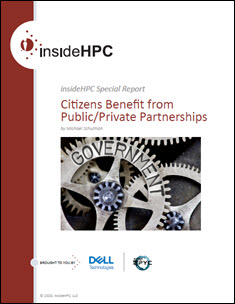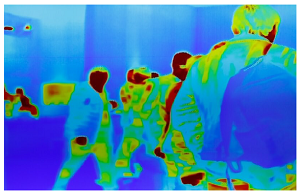 This special report sponsored by Dell Technologies, takes a look at how now more than ever, agencies from all levels of government are teaming with private Information Technology (IT) organizations to leverage AI and HPC to create and implement solutions that not only increase safety for all, but also provide a more streamlined and modern experience for citizens.
This special report sponsored by Dell Technologies, takes a look at how now more than ever, agencies from all levels of government are teaming with private Information Technology (IT) organizations to leverage AI and HPC to create and implement solutions that not only increase safety for all, but also provide a more streamlined and modern experience for citizens.
The massive amounts of information that are being generated today require modern, high-performance servers, fast networking and storage solutions that easily scale with increased workloads. Heterogeneous computing systems that incorporate various hardware components such as server accelerators can lead to faster and more efficient solutions that are vital for safety and security.
This technology guide, insideHPC Special Report: Citizens Benefit from Public/Private Partnerships, highlights a lineup of Ready Solutions created by Dell Technologies which are highly optimized and tuned hardware and software stacks for a variety of industries.
Public Sector Use of Advanced Computing Technologies
There are a wide range of areas in which government agencies are using AI and HPC technologies.
-
- Surveillance – Monitor known threats engaged in certain activities. Many instances exist where surveillance is in the best interest of safety.
- Emergency response – Predict and act on disasters. Responders can more easily make sense of disparate data and determine the best course of action.
- Search – Make sense of large amounts of unstructured data. Federal agencies deal with many types of data in order to make more informed decisions.
- Social services – Identify needs and issues before intervention is necessary. Social workers can more quickly determine if a situation might require immediate attention.
- Fraud detect on – Determine possible fraud based on data and patterns. Using large amounts of data from many sources can identify fraud earlier.
- Defense – Embedded in weapons systems and logistics systems. Using AI at the edge can lead to appropriate responses in real time.
Emergency response
When a disaster is predicted such as a hurricane, or happens unexpectedly such as an earthquake, masses of data are generated. One of the most important pieces of information is where survivors might be located, based on a number of factors. Much of this data will be unstructured (images, voice, IoT sensors), must be understood and put into a format that first responders need. Even before a disaster strikes, AI can help to position supplies, identify areas that might be most susceptible to property or personal damage. Setting up the response in advance can greatly reduce the costs and potentially save more lives.
With the worldwide pandemic of COVID-19, both public and private organizations are using all available technology resources to come up with treatments and stop the spread of the virus.
HPC systems are being used around the world to search for and develop effective vaccines and treatments. [2] Testing to determine who may be sick with the virus and quarantine has been shown to reduce the spread of the virus. In large gatherings, thermal imaging can help to quickly identify those with a fever.
 Search
Search
While search engines are great for research, more targeted searches that a government agency may need might require AI to narrow the results in almost real time. Determining property owners, the number of people in a specific area, or age of a group of people relies on massive amounts of unstructured data and will need state-of-the-art algorithms and HPC techniques.
Social services
Many factors may determine who is at risk in the social services arena. Using AI to determine if a child is at risk or whether a certain individual might be at an increased risk for substance abuse could benefit society as a whole. With AI, increasing monitoring or active intervention can be optimized, creating a safer environment.
Fraud detection
Fraud has become a serious problem worldwide. As more and more citizens go online for a variety of transactions, scams have become popular, robbing many of billions of dollars. Using HPC techniques, the potential exists to reduce this financial drain. Early identification of stolen credit card numbers and identity theft can save people from having their bank accounts drained, or possibly governments from having to raise taxes.
Defense systems
With immensely complex weapon systems needing to be on standby 24×7—often in remote and dangerous environments—AI techniques can greatly enhance the usefulness of these systems. AI can be used to predict when maintenance is needed, to enhance the performance of these systems, and to give operators more confidence in the operational readiness of the systems. In addition, but not just only for weapons, AI can make the supply chain more resilient as well.
Cybersecurity
Like fraud detection, threats are increasing online from many directions. Whether website phishing, malware, ransomware or network intrusions to gain personal and private information, organizations both public and private, must guard against this activity. AI can learn from previous electronic attacks and then modify filters and actions in real time.
Examples
 City of Las Vegas
City of Las Vegas
The city of Las Vegas is actively using AI as part of its Smart City initiative, aiming to make Las Vegas a safer city. A goal of this initiative is to decrease response times of first responders and to identify potential problems in advance. Las Vegas employs a wide range of technology in order to keep its citizens and visitors safe. A combination of video cameras, sound sensors and Internet of Things (IoT) devices allow safety officers to identify and respond to incidents quickly. The data observed can be compared to historical data to determine anomalies and then alert safety officers quickly. The real-time data can be actually analyzed at the edge where the incident is taking place, significantly decreasing the time that it takes to respond. Alerts can be issued for crowd safety based on a number of factors in real time, reducing the possibility of unruly gatherings and possible criminal activity. Many of these advancements and quick analytics are the result of a combination of new devices, cutting-edge technology and powerful servers.
 American Red Cross
American Red Cross
The American Red Cross was founded in 1881 and is dedicated to serving people in need. They received their first congressional charter in 1900 and have been tasked by the federal government with providing services to members of the American armed forces and their families as well as providing disaster relief in the United States and around the world.
One of the more visible activities of the American Red Cross is that of supplying blood where it is needed, especially in times of large disasters. By using a wide range of technologies, the American Red Cross can quickly set up blood donation centers in advance of anticipated need. By completely transforming their IT infrastructure over the past two years, the American Red Cross can determine where its employees might be needed, reducing delays and enhancing effectiveness. By analyzing weather predictions, for example, blood drives or product transportation can be positioned before disaster strikes.
U.S. Air Force
The U.S. Air Force is charged with protecting the nation’s airspace and developing technology for wartime operations. It’s a premier example of how a government-funded, large-scale, always on organization works with private industry to invest in advanced computer technology. In 2017, the U.S. Air Force joined with Dell Technologies to move much of their operations to the cloud. This $1 billion deal with the U.S. Air Force resulted in development of innovative technology solutions that address the needs of a leading organization and their movement to a cloud-based solution.
MIT Lincoln Labs
MIT Lincoln Labs works with a variety of organizations, both public and private, to develop advanced technologies that are used for various national security initiatives. MIT Lincoln Labs runs multiple compute clusters with thousands of cores in support of its 1,000+ researchers and various projects.
NOAA
National Oceanic and Atmospheric Administration (NOAA) is an agency within the U.S. Department of Commerce that focuses on the oceans and the atmosphere. NOAA monitors and observes various Earth systems through the use of instruments and data collection. NOAA also researches how these climatic systems change over time. NOAA is one of the major consumers of computing power in order to study climate change and make more accurate day-to-day weather predictions. NOAA has always been at the forefront of using large-scale computing systems and consistently upgrades their compute and storage infrastructure.

Over the next few weeks we will explore these topics surrounding citizens benefit from public/private partnerships centered around HPC and AI:
- Introduction, U.S. Government Commitment
- Public Sector Use of Advanced Computing, Technologies
- Dell Technologies Leadership, References
Download the complete insideHPC Special Report: Citizens Benefit from Public/Private Partnerships, courtesy of Dell Technologies.



